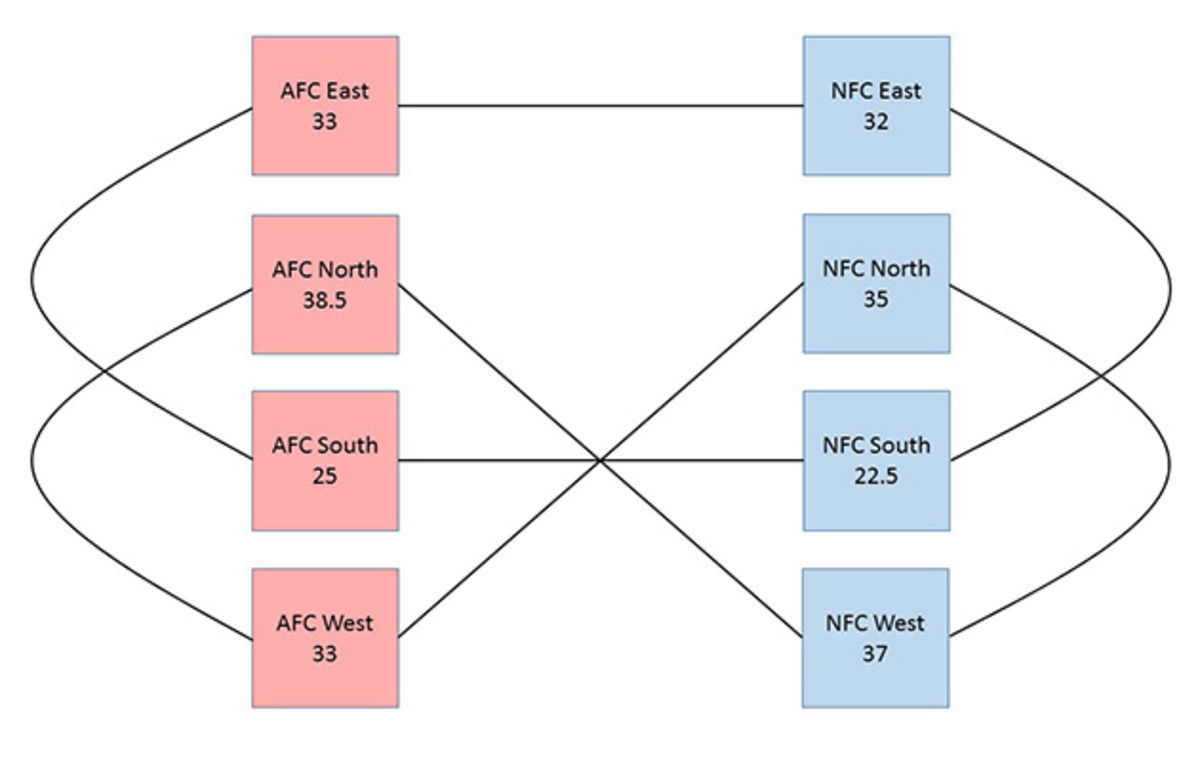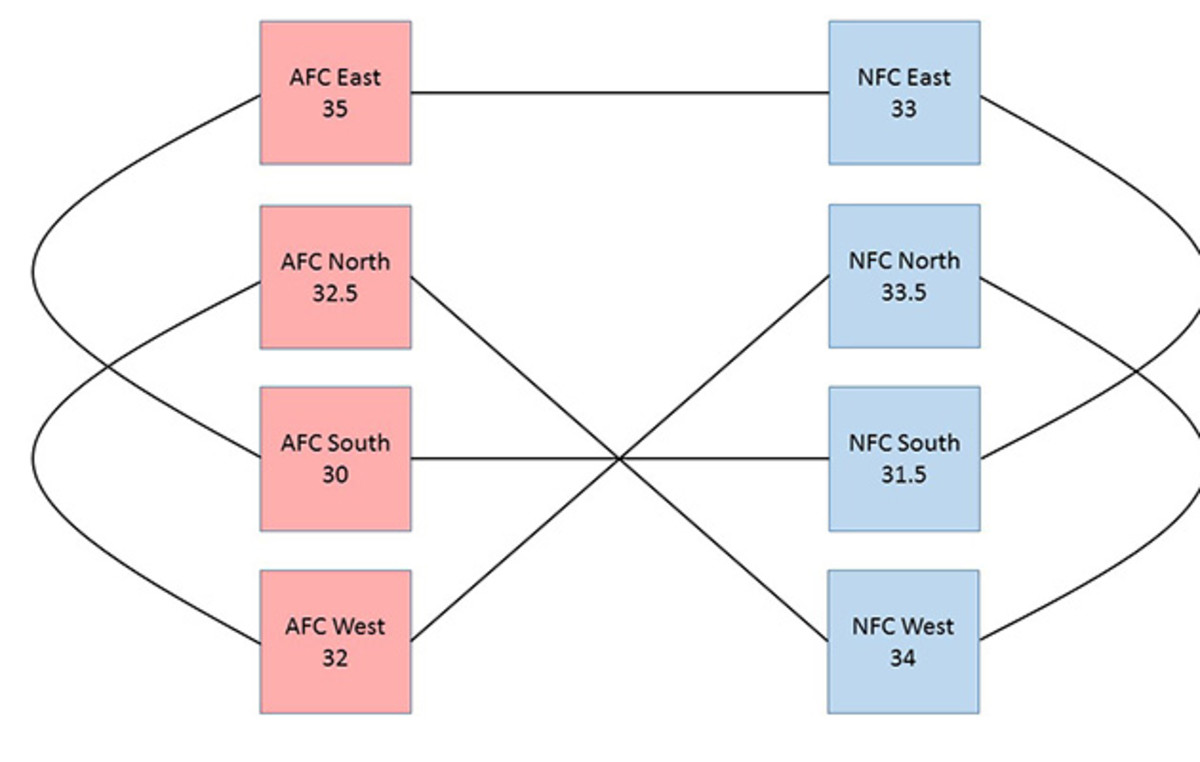Limitations of strength of schedule for predicting NFL teams' success

The NFL season is nearly upon us. Whether you’re finalizing your predictions or hunting for last-minute futures bets, one of the most common predictive tools we’re likely to see leading up to Week 1 is strength of schedule.
Most people calculate strength of schedule by adding up the record of a team’s 16 opponents and finding the cumulative win percentage. For example, Pittsburgh’s 16 opponents (counting division foes twice) went 147-107-2, so the Steelers’ SOS (if we count each tie as half a win) is .578—the highest in the NFL by this measure.
By this calculation, here is each team’s 2015 SOS, ranked from hardest to easiest:
| TEAM | SOS | # | TEAM | SOS |
|---|---|---|---|---|---|
1. | PITTSBURGH | 0.578 | 17. | MIAMI | 0.492 |
2. | CINCINNATI | 0.563 | 18. | NY JETS | 0.488 |
3. | SAN FRANCISCO | 0.561 | 19. | BUFFALO | 0.486 |
4. | SEATTLE | 0.559 | 20. | NY GIANTS | 0.479 |
5. | ARIZONA | 0.557 | 21. | WASHINGTON | 0.479 |
6. | ST. LOUIS | 0.553 | 22. | NEW ENGLAND | 0.477 |
7. | KANSAS CITY | 0.545 | 23. | PHILADELPHIA | 0.475 |
8. | OAKLAND | 0.545 | 24. | DALLAS | 0.467 |
9. | CLEVELAND | 0.543 | 25. | JACKSONVILLE | 0.463 |
10. | DENVER | 0.541 | 26. | TENNESSEE | 0.436 |
11. | BALTIMORE | 0.539 | 27. | CAROLINA | 0.434 |
12. | MINNESOTA | 0.539 | 28. | NEW ORLEANS | 0.430 |
13. | CHICAGO | 0.531 | 29. | TAMPA BAY | 0.426 |
14. | GREEN BAY | 0.529 | 30. | HOUSTON | 0.418 |
15. | DETROIT | 0.527 | 31. | INDIANAPOLIS | 0.416 |
16. | SAN DIEGO | 0.518 | 32. | ATLANTA | 0.410 |
It’s logical to be curious which teams have the easiest or hardest paths to the playoffs, but two key issues arise when most people try to evaluate schedules for an upcoming season: Each team’s finish within their division, and their overall win total, can be overstated.
The impact of the “first-place schedule” vs. the “last-place schedule” is less than most people realize
You’ve heard it before and you’ll hear it again: Teams that win their division have harder schedules than teams that finish behind them.
Well, yes and no.
The way the schedule is constructed, each team only plays two games against unique opponents from the rest of their division. These are the only two games affected by the previous year’s finish. The other 14 are unaffected: six division games, four games against an entire division within the conference and four against an entire division from the other conference.
Here’s a look at how the divisions match up this year, including cumulative win totals from 2014 to give an idea of the relative strength of each division:

Here are the eight divisions ranked by cumulative record in 2014:
DIVISION | TOTAL 2014 RECORD |
|---|---|
AFC NORTH | 38-25-1 |
NFC WEST | 37-27 |
NFC NORTH | 35-29 |
AFC EAST | 33-31 |
AFC WEST | 33-31 |
NFC EAST | 32-32 |
AFC SOUTH | 25-39 |
NFC SOUTH | 22-41-1 |
You can see that the AFC West and NFC West have comparatively difficult schedules this year, which could make it tougher on teams from those divisions to secure wild card berths. The NFC East and AFC South have easy schedules, largely because they won the NFC South lottery.
We shouldn’t totally discount each team’s finish within its own division the previous year, as that does still impact a team’s schedule relative to its division rivals.
But even that difference can be overstated. Last-place teams do cherry-pick the bottom teams from two intra-conference divisions, but they are far from guaranteed the easiest schedules. Let’s look at the AFC West as an example:
2014 PLACE | TEAM | 2014 RECORD | 2015 OPPONENTS' 2014 RECORD | 2015 SOS |
|---|---|---|---|---|
1 | BRONCOS | 12-4 | 138-117-1 | .541 |
2 | CHIEFS | 9-7 | 139-116-1 | .545 |
3 | CHARGERS | 9-7 | 132-123-1 | .518 |
4 | RAIDERS | 4-12 | 139-116-1 | .545 |
Notice the Raiders came in last place in 2014, granting them that oh-so-desirable last-place schedule, yet they are tied with the Chiefs for the hardest slate in the division. Why? Because the other three teams get to play the Raiders twice. Whatever difference the last-place schedule makes for the Raiders (their prize is a pair of games against the Jets and Titans), it’s mitigated by the fact that they have to play Denver twice (along with the other two division foes that finished above .500).
Of the 256 games on the entire regular season schedule, only 32 are paired up based on last year’s finish. If the Patriots struggle early in the season, there’s no doubt some people will offer up their first-place schedule as an explanation. After all, the Steelers, Cowboys and Colts all won their divisions last year and New England takes on all three in the first five weeks. But the Pats’ October road trip through Dallas and Indy has nothing to do with their finish last season.
• KING: Super Bowl 50 picks | SI STAFF: Final thoughts from training camps
Last year’s record isn’t the best way to project a team’s record the following season
Let’s go back to this time last year and consider what we expected going into the 2014 season. The Panthers were a 12-4 team in 2013, but few people outside of Charlotte expected them to win 12 games again. On the other end of the spectrum, the Texans were coming off a 2-14 campaign, but most people penciled them in for more than two wins the following year.
So if previous season win total isn’t the best way to predict, what’s a better metric to use? We can actually go with projected win totals out in Las Vegas. Those aren’t always exact either, but at least those numbers are attempting to predict the future instead of simply explaining the past.
Last August, the Westgate SuperBook in Las Vegas offered bets on the Panthers’ season win total over or under 8 (they went 7-8-1) and Houston was offered at 7.5 wins (it went 9-7). Neither were exactly right, but both projections were closer approximations of the teams’ 2014 records than simply copying over the real-life win total from the season before. The Panthers dropped by five wins, the Texans improved by seven wins and the Westgate projections got most of the way there.
Here are all 32 teams with their 2014 win totals and 2015 win total projections offered by the Westgate SuperBook on August 22.
(Note that ties in 2014 are listed as half a win for purposes of calculating winning percentages, while decimals in the 2015 projected win totals mean the line was set between two whole numbers.)
TEAM | 2014 WINS | 2015 PROJ. | TEAM | 2014 WINS | 2015 PROJ. |
|---|---|---|---|---|---|
ARIZONA | 11 | 8.5 | MIAMI | 8 | 9 |
ATLANTA | 6 | 8.5 | MINNESOTA | 7 | 7.5 |
BALTIMORE | 10 | 9 | NEW ENGLAND | 12 | 10 |
BUFFALO | 9 | 8.5 | NEW ORLEANS | 7 | 8.5 |
CAROLINA | 7.5 | 8.5 | NY GIANTS | 6 | 8 |
CHICAGO | 5 | 6.5 | NY JETS | 4 | 7.5 |
CINCINNATI | 10.5 | 8.5 | OAKLAND | 3 | 5.5 |
CLEVELAND | 7 | 6.5 | PHILADELPHIA | 10 | 9.5 |
DALLAS | 12 | 9.5 | PITTSBURGH | 11 | 8.5 |
DENVER | 12 | 10 | SAN DIEGO | 9 | 8 |
DETROIT | 11 | 8.5 | SAN FRANCISCO | 8 | 6.5 |
GREEN BAY | 12 | 11 | SEATTLE | 12 | 11 |
HOUSTON | 9 | 8.5 | ST. LOUIS | 6 | 8 |
INDIANAPOLIS | 11 | 10.5 | TAMPA BAY | 2 | 6 |
JACKSONVILLE | 3 | 5.5 | TENNESSEE | 2 | 5.5 |
KANSAS CITY | 9 | 8.5 | WASHINGTON | 4 | 6 |
While we’re at it, we can also redraw the divisional match-up graph, this time using Vegas win projections:

Right off the bat we see that the divisions have been pushed toward the middle. The range between the best and worst divisions last season was 16, but the range based on this year’s win total projections is only five. The NFC South has gained nine wins (and is no longer considered the weakest division), and the AFC North has been dropped six wins (and is no longer the strongest).
• BURKE: All-Pro predictions: Who'll take home top honors?
But enough about divisions.
Let’s go back and recalculate each team’s individual “Vegas SOS” based on 2015 projections. Again, this is just the cumulative win percentage of all 16 opponents, but we’ll input the Westgate projections instead of 2014 wins.
For reference, each team’s original SOS based on 2014 records is in the adjacent column. I’ll count ties as half a win to calculate winning percentage, even though a record of 6-9-1 would not count as 6.5 wins if you were betting on that number at a casino.
| TEAM | VEGAS SOS | 2014 SOS | # | TEAM | VEGAS SOS | 2014 SOS |
|---|---|---|---|---|---|---|---|
1. | SAN FRANCISCO | 0.537 | 0.561 | 17 | DENVER | 0.510 | 0.541 |
2. | DALLAS | 0.529 | 0.467 | 18 | NY GIANTS | 0.510 | 0.479 |
3. | ARIZONA | 0.527 | 0.557 | 19. | PHILADELPHIA | 0.510 | 0.475 |
4. | WASHINGTON | 0.527 | 0.479 | 20. | KANSAS CITY | 0.508 | 0.545 |
5. | MINNESOTA | 0.525 | 0.539 | 21. | NY JETS | 0.508 | 0.488 |
6. | PITTSBURGH | 0.525 | 0.578 | 22. | SEATTLE | 0.508 | 0.559 |
7. | DETROIT | 0.523 | 0.527 | 23. | ST. LOUIS | 0.508 | 0.553 |
8. | BUFFALO | 0.520 | 0.486 | 24. | GREEN BAY | 0.504 | 0.529 |
9. | JACKSONVILLE | 0.518 | 0.463 | 25. | SAN DIEGO | 0.502 | 0.518 |
10. | CHICAGO | 0.516 | 0.531 | 26. | TAMPA BAY | 0.502 | 0.426 |
11. | MIAMI | 0.516 | 0.492 | 27. | BALTIMORE | 0.498 | 0.539 |
12. | OAKLAND | 0.516 | 0.545 | 28. | TENNESSEE | 0.498 | 0.436 |
13. | NEW ENGLAND | 0.514 | 0.477 | 29. | HOUSTON | 0.494 | 0.418 |
14. | CAROLINA | 0.512 | 0.434 | 30. | NEW ORLEANS | 0.492 | 0.430 |
15. | CINCINNATI | 0.512 | 0.563 | 31. | INDIANAPOLIS | 0.484 | 0.416 |
16. | CLEVELAND | 0.512 | 0.543 | 32. | ATLANTA | 0.480 | 0.410 |
It can be dangerous to put too much stock in this data—it’s more like a fun exercise— but we can glean a few quick observations.
If we calculate the difference between each team’s 2014 SOS and Vegas SOS, these five teams have the biggest jump, indicating a tougher schedule than last year’s records (and the typical SOS you might see on a pregame show) would dictate:
| TEAM | 2014 SOS | VEGAS SOS | DIFFERENCE |
|---|---|---|---|---|
1 | CAROLINA | 0.434 | 0.512 | 0.078 |
2 | TAMPA BAY | 0.426 | 0.502 | 0.076 |
3 | HOUSTON | 0.418 | 0.494 | 0.076 |
4 | ATLANTA | 0.410 | 0.480 | 0.070 |
5 | INDIANAPOLIS | 0.416 | 0.484 | 0.068 |
It’s no surprise all five teams are housed in the NFC South or AFC South, two divisions the Westgate projects to tally more wins than last year (thus making each team’s schedule tougher).
So not surprisingly, the five teams treated best by Vegas SOS come from divisions expected to regress and be weaker than last year:
| TEAM | 2014 SOS | VEGAS SOS | DIFFERENCE |
|---|---|---|---|---|
1 | PITTSBURGH | 0.578 | 0.525 | -0.053 |
2 | CINCINNATI | 0.563 | 0.512 | -0.051 |
3 | SEATTLE | 0.559 | 0.508 | -0.051 |
4 | ST. LOUIS | 0.553 | 0.508 | -0.045 |
5 | BALTIMORE | 0.539 | 0.498 | -0.041 |
Pittsburgh, which by the traditional measure had the toughest SOS in football, gets a little bit of a breather if we measure based on season projections instead of last season’s finish. Of course, so do both of the Steelers’ chief division rivals. But the Steelers drop from having the toughest schedule in football to the sixth-toughest.
Admittedly this system is not perfect either. For one thing, the projections at the Westgate SuperBook should take strength of schedule into account to some degree.
There’s also the matter that teams across the league will still either overperform or underperform their projections. I used examples like Carolina and Houston, but there were also teams last season that were significantly better (Arizona) or worse (New Orleans) than expected.
Certain teams will miss simply because the projections tend to be conservative. No team is projected for fewer than 5.5 wins or for more than 11, though it’s likely at least one team will go worse than 4-12 and another will go better than 12-4.
But last year’s SuperBook projections were, on average, slightly closer to predicting each team’s record than the previous season record. One year is a small sample size, but the SuperBook also had more teams within twp games of the actual total, more within three games and more within four games.
• GOLDICH: A primer to NFL futures betting for 2015
*****
So what can we learn from this whole exercise? How much of it is valuable, and how much is just empty noise? The key thing to take away is that the whole concept of measuring SOS has some flaws.
At the end of the day, we don’t know precisely how difficult a team’s schedule will be. There are too many variables if we try looking too many weeks in advance. A team might catch an opponent after its best player is hurt or suspended, or after a team has “committed to rebuilding for the season” (read: eyeing the No. 1 pick in the draft) or while it’s resting up for the playoffs.
So if you want to judge a team’s whole schedule, you’re better off analyzing things like two- or three-game road trips, total miles traveled, when bye week falls, which division opponents you catch on a short week, etc.
But if we’re going to use strength of schedule, which many prognosticators will do anyway, we might as well understand the limitations of its scope, and use the best numbers we can.
